

Around the World Blog: CRIME IN ARGENTINA, TAKE TWO. One of the highlights of traveling is always the folks you meet.

My trip to Argentina was especially rich in this way and I was lucky that so many people in Argentina speak English and that my L.A. Spanish got me around otherwise. One of the people I was most impressed with is a remarkable woman named Amelia, a music business connection, who I went to dinner with when I first arrived. Our mutual friend Steve, k.d. lang's manager, had introduced us via e-mail. Amelia had been arrested during the time when the generals ran a fascist state in Argentina (the most recent, historically speaking)-- and she's a vegetarian; we got along great. By Amelia Lafferriere Buenos Aires, where, as you so correctly mention, half of the population live if we put together the Capital and Gran Buenos Aires, started its process of economic and then social degradation. What I can conclude is that Buenos Aires at this time has more insecurity and less safety than it had ten years ago. 1-s2.0-S0197397502000723-main.pdf (application/pdf Object)
LOP Favelas - Architecture of Survival. Pedro Lobo Brazilian contemporary problems have their origins in slavery.

Slaves were “freed” in 1888, because plantation owners worked out that it would be cheaper to hire Afro-Brazilian or European labourers. Almost 8 million people were simply turned loose on the roads. No housing, placement, education, job opportunities or health care were provided. AHI: United States » Favelas of Sao Paulo: Part 2, Guarapiranga. AHI: United States » Favelas of Sao Paulo: Part 1, Cingapura. A while back I spent 4½ days in Sao Paulo – my first time in Brazil – getting an immersion tour in why and where and how the municipality and state of Sao Paulo have tackled slum upgrading and urbanization.
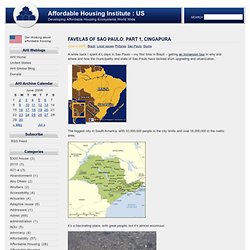
Urban analysis of favelas. La Ciudad Imaginaria: Las favelas, villas... el urbanismo espontáneo. Las favelas, las villas, son una arquitectura nacida de la miseria, una arquitectura precaría, que ha pervivido en el tiempo y se ha institucionalizado por la realidad social.

No es una arquitectura que esté pensada para pervivir más allá del uso que se le da. Algunas favelas están construídas sobre montañas de basura. Esto, junto a la ausencia de una red de alcantarillado o agua potable hacen que los problemas sanitarios sean cotidianos.Sudamérica ha visto crecer estos "barrios", sobre todo en la segunda mitad del siglo XX cuando se produce una gran afluencia del campo a las grandes ciudades: Río de Janeíro, Buenos Aires, Bogotá, Caracas... las autoridades políticas no pudieron, o supieron, dar una respuesta al problema de vivienda que se presentó con la llegada de miles, millones, de personas con escasos recursos que buscaban mejor vida en la ciudad.
Who’s Afraid of the Informal?: slum as an analytical category « Photo montage by Dionsio Gonzales Continuing the dialogical debate between FAVELissues writers about the conflation of informality and slums at the glocal scale.
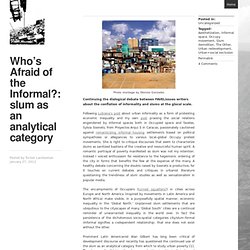
Following Lubiana’s post about urban informality as a form of protesting economic inequality and my own post praising the social relations engendered by informal spaces both in Occupied space and favelas, Sylvia Soonets, from Proyectos Arqui 5 in Caracas, passionately cautioned against romanticizing informal housing settlements based on political sympathizes or allegiances to various local–global Occupy protest movements. She is right to critique discourses that seem to characterize slums as sanitized bastions of the creative and resourceful human spirit.
A romantic portrayal of poverty manifested as slum was not my intention. Instead I voiced enthusiasm for resistance to the hegemonic ordering of the city in forms that benefits the few at the expense of the many. The tricky question of calling a “slum” a slum « Favela: Janice Perlman. The tricky question of calling a “slum” a slum «
Source: – London (Left, 1880) and Mumbai (Right, 2009) slums, London ( Mumbai (Author’s, Betwala Chawl) Since most of our contributions in our delicious favelissues blog deal with slum or informal settlements I wanted to share with you today a brief analysis of the history and diversity of how we define “slums”.
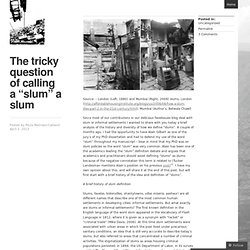
A couple of months ago, I had the opportunity to have Alain Gilbert as one of the jury’s of my PhD dissertation and had to defend my use of the word “slum” throughout my manuscript – bear in mind that my PhD was on slum policies so the word “slum” was very common. Alain has been one of the academics leading the “slum” definition debate and argues that academics and practitioners should avoid defining “slums” as slums because of the negative connotation this term is related to (Tucker Landesman mentions Alain’s position on his previous post)[2].
A brief history of slum definition. Search Results - ProQuest. The resource you are accessing has been identified as secure content.

This site is currently verifying your digital identity. For most web browsers this process is automatic, you will be taken to your original resource upon completion. The verification process is encrypted to protect your digital identity. Tucker Landesman « Untitled. Global Studio Bhopal Resources. Urban Attributes - Andalusia Center for Contemporary Art. With the coining of the term Terrain Vague, Ignasi de Solà-Morales is interested in the form of absence in the contemporary metropolis.
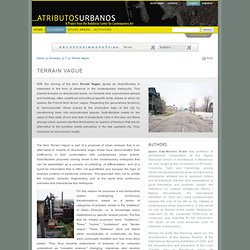
This interest focuses on abandoned areas, on obsolete and unproductive spaces and buildings, often undefined and without specific limits, places to which he applies the French term terrain vague. Regarding the generalized tendency to "reincorporate" these places to the productive logic of the city by transforming them into reconstructed spaces, Solà-Morales insists on the value of their state of ruin and lack of productivity. Only in this way can these strange urban spaces manifest themselves as spaces of freedom that are an alternative to the lucrative reality prevailing in the late capitalist city. They represent an anonymous reality. The Perfect Slum. Reinventing America's Cities: Discovering Opportunities by Challenging Biases. The current economic crisis, increasing ecological concerns, and growing urban populations are remarkable opportunities for innovative thinking and strategic policies to redesign our cities.
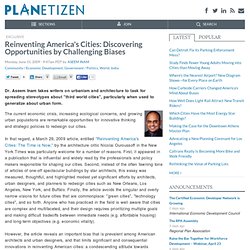
Christopher Alexander. Christopher Alexander Christopher Wolfgang Alexander (born October 4, 1936 in Vienna, Austria) is an architect noted for his theories about design, and for more than 200 building projects in California, Japan, Mexico and around the world.

Reasoning that users know more about the buildings they need than any architect could, he produced and validated (in collaboration with Sarah Ishikawa and Murray Silverstein) a "pattern language" designed to empower anyone to design and build at any scale. Alexander is often overlooked by texts in the history and theory of architecture because his work intentionally disregards contemporary architectural discourse.[1] As such, Alexander is widely considered to occupy a place outside the discipline, the discourse, and the practice of Architecture. [citation needed] In 1958, he moved from England to the United States, living and teaching in Berkeley, California from 1963. He is professor emeritus at the University of California, Berkeley. Education[edit] The Rise And Fall Of Poverty Porn. The dramatic pseudo-orchestral music of '80s action-movie schlock begins.